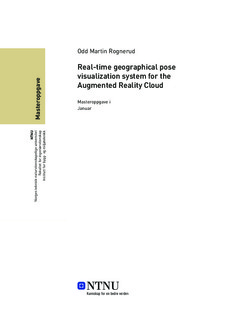Real-time geographical pose visualization system for the Augmented Reality Cloud
Abstract
Denne oppgaven utforsker de underliggende teknologiene som muliggjør lokalisering og kartlegging i moderne Augmented Reality-systemer, såvel som eldre Augmented Reality-systemer. Spesielt er det satt fokus på Augmented Reality skyen og økosystemet rundt denne, en viktig del av fremtidig teknologisk infrastruktur som kommer til å muliggjøre persisterende, interoperatibel og fler-bruker Augmented Reality opplevelser. Videre, ved å bruke prinsipper fra Maskinsyn, GIS og Informasjonsteknologi, er et sanntids system utviklet for å visualisere mobile enheters geografiske posisjon og orientering på en virtuell globe i en WebGL kompatibel web-leser. Teknologier anvedt inkluderer OpenCV, WebSockets, Cesium.js og Node.js på tre forskjellige platformer; web, server og Android. This thesis explores the technologies that power the tracking and mapping under the hoodof modern Augmented Reality systems, as well as previous iterations of Mobile Augmented Reality. Special attention is given to the so-called Augmented Reality Cloud andthe eco-system around it, a crucial infrastructure piece for enabling persistent, interoperable and multi-user Augmented Reality experiences. Furthermore, by using principals fromComputer Vision, GIS and Information Technology, a real-time system is developed thatvisualizes mobile device geopose on a virtual globe running in a WebGL enabled browser.Technologies applied include OpenCV, WebSockets, Cesium.js and Node.js on in threedifferent environments; web, server and Android.
